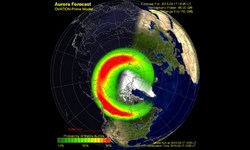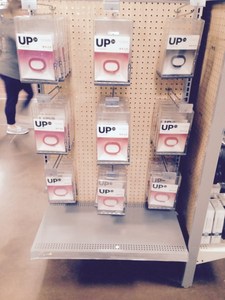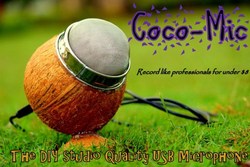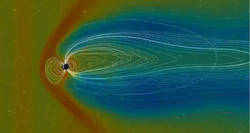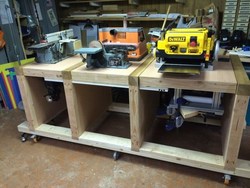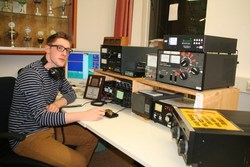 March 25, 2015 Editor: Ward Silver, NØAX | |||||||
IN THIS ISSUE
NEW HF OPERATORS - THINGS TO DO It's a "Two-fer Thursday" as the NS Sprint combines back-to-back modes into one fun evening, beginning with a 30-minute RTTY sprint at 0145Z followed by a 15-minute break. Then the 30-minute NS CW Sprint hits the bands. The NS Sprints are weekly, every Thursday evening in North America, and a great way to keep the radiosport juices flowing. BULLETINS There are no bulletins in this issue. BUSTED QSOS Dave W9PA noted that K3LR's CW Skimmers use Perseus SDR Radios - not the QS1R. 3V8SS operator Ali's call sign is F4HJD. (Thanks, Ash 3V/KF5EYY) CONTEST SUMMARY Complete information for all contests follows the Conversation section March 28-29
April 4-5
The Dayton Hamvention has announced the winners of this year's three awards:
The Central States VHF Society's 49th annual conference will be held in Denver, Colorado from Thursday, July 23rd through Sunday, July 26th, sponsored by Rocky Mountain Ham Radio. Papers, presentations, and poster displays are being solicited with a deadline for publication of April 22. Questions concerning papers, presentations and poster displays should be directed to the Program Chairman, John Maxwell WØVG. Elecraft has announced an upgrade to the KSYN3 synthesizer boards for the K3 transceiver. Not only does the upgrade support high-speed full break-in CW without special configurations or disabling of features, it improves the already top-of-the-line noise performance. With the importance of clean signals being recognized as the necessary complement to receiver linearity, this is a welcome example of state-of-art amateur design. (Thanks, Bob N6TV) Jeff WK6I announces that ticket sales are now open for the Contest Dinner at the annual International DX Convention in Visalia, California. Pre-paid reservations are required - no ticket sales at the door! Held on Friday, April 17, WRTC 2014 Chairman, Doug Grant K1DG, will provide behind-the-scenes commentary and anectdotes to the excellent video on the event produced by 9V1YC.
In the "turnabout is fair play department" we hear that RFI from those horrendous electronic ballasts are attracting the attention of the local constabulary. Why? It seems their use is often associated with illicit "indoor agriculture" and not only can they be heard tearing up the ham bands, but AM broadcast, too! Driving around with the radio tuned between stations has never been so much fun! If your club has been hosting speakers giving programs via Skype or other over-the-web services via a WiFi connection, you might want to have folks turn off their mobile gear. As reported by Tom ABØJ and Tim K3LR, glitches in their wireless link to the Internet was eventually solved by having club members put their phones in Airplane Mode. Once the phones were off, the program continued without a hitch! Creating the opportunity for a whole new class of Field Day operation - I'm thinking "S for Sweaty" - you will soon be able to charge up your batteries just by wearing these special triboelectric clothes! (Thanks, Dennis N6KI) Tomas NW7US has put a vigorous new spin on the Propagation reflector's daily content. The daily posting now includes links to stories about that day's solar ctivity, as well as geomagnetic and ionospheric conditions. There is new material every day with special stories about breaking news, such as the big flares last week. More Maker Faires are coming up here and in Europe:
The Daily DX relayed news of an interesting website "How to Find Old Amateur Radio Call Signs". I think we've all discovered an old QSL somewhere and these are some great suggestions for finding out more about those early hams. Champ E21EIC reports that Ivy 9W6IVY passed all three elements of the US amateur exams in a VE session held in Bangkok, Thailand over the weekend. Her father is 9M6YBG so you may be hearing much more on the bands from this 14-year-old Extra class licensee! Web Site of the Week - The blog EDN Moments provides a regular stream of interesting historical tidbits, such as early radio transmissions by Popov. On March 24, 1896, he is reported to have sent the words "Heinrich Hertz" between buildings on the St Petersburg University campus. We know much more of Marconi but Tesla, Popov, Fessenden, Loomis, and others all made various advances and contributions as the technology emerged. WORD TO THE WISE At 1815 UTC on 18 March, the SFI was 114, the A was 117, and the K was 6. Observes Doug K1DG, "Not sure if I have ever seen the A index higher than the solar flux. Well, maybe when the SFI was in the 60s. This is like a triple-double of assists, steals, and blocked shots."
Congratulations to the LY7A club at the Kaunas University of Technology on their 50th anniversary! Henryk SMØJHF has documented the history of the club in an extensive article with pictures. The Daily DX reports two new sets of African DXpedition photos by Nigel G3TXF from his recent V5/G3TXF operations in Namibia and Dom M1KTA has also posted a wrapup of his adventures in The Gamiba as C5/M1KTA. The complete package of 2014 ARRL November CW Sweepstakes results are now available: the writeup was authored by Kelly VE4XT, Line Scores were generated in the attractive new format developed by John K9JK, the searchable database is live, and everyone's Log Checking Report (LCR) is ready to be downloaded. ARRL Contest Branch Manager, Matt W1MSW, reports that the Contest Awards page is now up to date, as well, reflecting all of the hard work it has taken to get the awards back on schedule.
Results for the February edition of the School Club Roundup are also final and will be noted as such very soon. Participation was way up this year and there are some big scores reflecting the higher interest in this contest. Preliminary results for the February North American QSO Party - RTTY are now available at the National Contest Journal web site. Final results will be published in the May/June issue of the National Contest Journal. (Thanks, NAQP RTTY Manager, Mark K6UFO) The recent SSB Sprint contest roared back to life with 382 logs submitted, and 17 logs with more than 300 QSOs, including a 402-QSO effort by KØEU. All 50 states and nearly all of the Canadian provinces were active with three stations reporting Worked All States and KW8N reported the top multiplier total of 66. Stay tuned for final results and announcements of prize winners and future contests. (Thanks, Bob KW8N) If yours was one of the 104 stations which participated in the November 2014 Frequency Measuring Test and reported the frequency of W1AW/5 close enough to the actual frequency, a link to your downloadable certificate has been emailed. The April FMT is coming up on April 8th. (Thanks, Bruce WA7BNM) OPERATING TIP Continuing our basketball theme - pass the ball! Or, rather, the multipliers. This is especially true at multi-op teams and is one of the easiest ways to add quite a bit to your score. Make it a habit to keep an eye on whatever means your logging software provides to tell where that multiplier is needed. Then get in the habit of asking the calling station to work your team on other bands. Sooner or later you'll get a three- or four-band pass "all around the horn" and get those mult bells ringing! How noisy is it? James, KK6MC, a.k.a. "Dr Megacycle" reports that "NTIA/ITS had a recently active program measuring surveying the spectrum at various US sites, including Chicago, Denver and San Diego quite recently." The NTIA/ITS technical reports/memos/papers are available online, including this April 2014 report on the Chicago area.
How many inventions or discoveries of amazing new materials are heralded as "changing the course of civilization"? Of course they all do by definition, but graphene's interesting properties certainly seem capable of justifying the hyperbole - perhaps as much as concrete and steel. Keep an eye on this stuff! Dennis N6KI has discovered more interesting gadgets from cyberspace, such as the world's first fully digital radio transmitter built purely from microprocessor technology and a company that repurposes old iPhones as vintage radios. You know how your dentist wants you to floss regularly? Well, Tom W2SC/8P5A found another great use for disposable flossing brushes. Since his gear is frequently idle in the island air, corrosion and dust can cause aggravating intermittents or open contacts. Time for a good flossing? "The idea is to take Interdent brushes...dip them in alcohol and clean the inside of the connector...There were bristles for some wiping action, but they were flexible enough not to bend the contacts. For me, this instantly brought some connectors back to life (with) no intermittents all weekend." I love being part of a worldwide community that involves everything from interplanetary science to using dental accessories for cleaning connectors - at the same time. Gerry, W1VE recommends the AP800 or XAP800 Conferencing Microphone Mixer with 8 inputs, 8 outputs, digital controls, and an RS-232 interface. He also likes the macros that can be keyed to a footswitch contact closure. The price is certainly right at around $30 to $50 online. Technical Web Site of the Week - The Magnetospheric Multiscale Mission satellites - all four of them - launched on March 12th. Soon they will begin an interesting experiment . After all, "Magnetic reconnection could be the Universe's favorite way to make things explode." Hams are on the front lines of experiencing those effects, too! Up to the Challenge? As you might note from the web page of results, this February's edition of the School Club Roundup attracted quite a few participants. Scores are up, number of contacts are up, lots of students spent time behind the mike or keyboard, and numerous other hams were in there contributing contacts and encouragement. (A special note of thanks is due WA7BNM for his efforts to provide an online reporting and results service that is well-suited to the timeline of students.) Since we are in the middle of the US college basketball playoffs known as "March Madness," perhaps certain comparisons can be made. While there is no doubt that nearly all students will not become NBA players, there is also no doubt that competitions like basketball generate a lot more enthusiasm than, say, final exams! So - why not have more events to attract folks to ham radio, assuming they can be conducted and reported on in a timely fashion, viewed by spectators, and rewarded with the appropriate enthusiasm?
These need not all be contests, per se. There are lots of other ways to get the juices flowing. For example, AMSAT reports that Tim Peake KG5BVI, the first British ESA astronaut, has issued an invitation to UK school pupils to contact him via Amateur Radio whilst he is in space. Tim is scheduled to join the crew of the International Space Station (ISS) in November of this year and will spend six months working and living on the ISS. Sound a little bit like a DXpedition? While he's on board the ISS, UK school pupils will be able to contact him during a scheduled Amateur Radio link-up. So what, you say, that's just the same-old-same-old. Not exactly - there's a catch. Students taking part in the link-up will have to obtain their full Amateur Radio license to be eligible to operate the radio and only one lucky student at each of the selected schools will be responsible for making contact with the ISS. Game on! Another competition is being conducted in the Boston area - for student robot builders. The Robot Sprint Challenge is sponsored by robot manufacturer Vecna Tecnologies as described in the article "Robot racing sparks scientific enthusiasm in U.S. students". The task is simple - be the fastest one to cover the 100-yard course in both directions and grab a cup of confetti at the turnaround. Design concepts span "The Walrus" to "Hydro Dog". Teams can be as sophisticated or as unsophisticated as they want. There is no guarantee that fancy, high-tech designs will win, either. Take for example, the underwater robot built by four immigrant high-school students that beat robots from high-power engineering schools. I once watched a robot maze-running challenge in which the winning robot's entire controller consisted of one relay and a wall-sensing microswitch. On the other hand, a little smarts and good design may be a better bet! Three weeks ago I was part of a team of judges, most of whom were hams, evaluating dozens of entries in a student robotics competition sponsored by General Motors. The task was to simulate a tool-selecting robot that might be part of a manufacturing plant. Given a set of programmable Lego motors, a large box of bricks, and an unlimited supply of rubber bands, the variation in designs that met the requirements was striking. The middle- and high-school teams were focused and intense. And competitive! This competitive energy is a natural path to discovering and participating in ham radio. Contesting and various forms of radiosport certainly provide the framework. So where are the teams? Where are our challenges, our "Walrus," our "Hydro Dog" entries? We need competitions students can enter on their own terms with technology they can work with and understand. Let's build on the challenges that brought us into ham radio so that we can bring in the students and young adults. Are we up to that challenge? Game on! 25 March through 7 April An expanded, downloadable version of QST's Contest Corral in PDF format is available. Check the sponsor's Web site for information on operating time restrictions and other instructions. HF CONTESTS FOC QSO Party--CW, from Mar 28, 0000Z to Mar 29, 2359Z. Bands (MHz): 1.8-28, 50+. Exchange: RST, name, FOC nr if member. Logs due: 7 days. Rules CQ WPX SSB Contest--Phone, from Mar 28, 0000Z to Mar 29, 2359Z. Bands (MHz): 1.8-28. Exchange: RS and serial. Logs due: 5 days. Rules Worldwide EME Contest--Phone,CW, from Mar 28, 0000Z to Mar 29, 2400Z. Bands (MHz): 3.4G. Exchange: TMO/RS(T) and "R". Logs due: Jun 15. Rules CWOps Weekly Mini-CWT Tests--CW, from Apr 1, 1300Z - See website. Multiple time periods. Bands (MHz): 1.8-28. Weekly on Wednesday, 28 to 38 kHz above band edge. Exchange: Name, member number or S/P/C. Logs due: 2 days. Rules Lighthouse Spring Lites QSO Party--Phone,CW,Digital, from Apr 3, 0001Z to Apr 12, 2359Z. Bands (MHz): 1.8-28. See website. Exchange: ARLHS number or serial, name, S/P/C. Logs due: Apr 30. Rules NS Weekly RTTY Sprint--Digital, from Apr 3, 0145Z to Apr 3, 0215Z. Bands (MHz): 1.8-14. Weekly on Thursday evenings local time. Exchange: Serial, name, and S/P/C. Logs due: 2 days. Rules NS Weekly Sprint--CW, from Apr 3, 0230Z to Apr 3, 0300Z. Bands (MHz): 1.8-14. Weekly on Thursday evenings local time. Exchange: Serial, name, and S/P/C. Logs due: 2 days. Rules LZ Open 40 Meter Contest--CW, from Apr 4, 0400Z to Apr 4, 0800Z. Bands (MHz): 7. Exchange: 6-digit serial and serial from previous QSO. Logs due: 10 days. Rules QRP ARCI Spring QSO Party--CW, from Apr 4, 1200Z to Apr 5, 2359Z. Bands (MHz): 1.8-28. QRP calling frequencies. Exchange: RST, S/P/C, power or QRP ARCI number. Logs due: 14 days. Rules Texas State Parks Contest--Phone,CW,Digital, from Apr 4, 1400Z to Apr 5, 0159Z. Bands (MHz): 3.5-28, 50. Exchange: Call sign and TX park ID, S/P or "DX". Logs due: 14 days. Rules Mississippi QSO Party--Phone,CW,Digital, from Apr 4, 1400Z to Apr 5, 0200Z. Bands (MHz): 3.5-28, 50-432, CW 50 kHz above band edge; Phone 3.862, 7.195, 14.270, 21.370, 28.370 MHz;Digital per band plan. Exchange: RS(T) and MS county or S/P/C. Logs due: Apr 30. Rules Missouri QSO Party--Phone,CW,Digital, from Apr 4, 1400Z - See website. Multiple time periods. Bands (MHz): 1.8-28, 50-432, CW 1.820 and 40 kHz from band edge; Phone--1.880,3.825,7.220,14.250,21.380,28.350 MHz; Digital--80 kHz from band edge; VHF/UHF--see website. Exchange: RS(T), MO county or S/P/C. Logs due: May 4. Rules SP DX Contest--Phone,CW, from Apr 4, 1500Z to Apr 5, 1500Z . Bands (MHz): 1.8-28. Exchange: RS(T) and serial or SP province. Logs due: May 10. Rules PODXS 31 Flavors Contest--Digital, from Apr 4, 1600Z to Apr 4, 2200Z. Bands (MHz): 14. 14.070-14.080 MHz. Exchange: S/P/C and name or 070 number. Logs due: Apr 18. Rules EA RTTY Contest--Digital, from Apr 4, 1600Z to Apr 5, 1600Z . Bands (MHz): 3.5-28. Exchange: RST, serial or EA province. Logs due: 15 days. Rules Montana QSO Party--Phone,CW,Digital, from Apr 4, 1800Z to Apr 5, 1800Z. Bands (MHz): 1.8-28, 50-432. Exchange: RS(T) and MT county or S/P/C. Logs due: 7 days. Rules Low Power Spring Sprint--CW, from Apr 6, 1400Z to Apr 6, 2000Z . Bands (MHz): 1.8-28. Exchange: RST, 4-char grid square, power category. Logs due: 30 days. Rules Easter Contest--Phone,CW, from Apr 6, 1500Z to Apr 6, 1730Z. Bands (MHz): 3.5-7. Exchange: RS(T), DOK nr, "NM" (non-mbr) or serial. Logs due: 3 weeks. Rules OK1WC Memorial Contest--Phone,CW, from Apr 6, 1630Z to Apr 6, 1730Z. Bands (MHz): 3.5, 7. Weekly on Monday, see website for bands. Exchange: RS(T) and serial. Logs due: 5 days. Rules ARS Spartan Sprint--CW, from Apr 7, 0200Z to Apr 7, 0400Z. Bands (MHz): 3.5-28. Monthly on the first Monday evening local time. Exchange: RST, S/P/C, and power. Logs due: 2 days. Rules VHF+ CONTESTS FOC QSO Party--CW, from Mar 28, 0000Z to Mar 29, 2359Z. Bands (MHz): 1.8-28, 50+. Exchange: RST, name, FOC nr if member. Logs due: 7 days. Rules Worldwide EME Contest--Phone,CW, from Mar 28, 0000Z to Mar 29, 2400Z. Bands (MHz): 3.4G. Exchange: TMO/RS(T) and "R". Logs due: Jun 15. Rules Texas State Parks Contest--Phone,CW,Digital, from Apr 4, 1400Z to Apr 5, 0159Z. Bands (MHz): 3.5-28, 50. Exchange: Call sign and TX park ID, S/P or "DX". Logs due: 14 days. Rules Mississippi QSO Party--Phone,CW,Digital, from Apr 4, 1400Z to Apr 5, 0200Z. Bands (MHz): 3.5-28, 50-432, CW 50 kHz above band edge; Phone 3.862, 7.195, 14.270, 21.370, 28.370 MHz;Digital per band plan. Exchange: RS(T) and MS county or S/P/C. Logs due: Apr 30. Rules Missouri QSO Party--Phone,CW,Digital, from Apr 4, 1400Z - See website. Multiple time periods. Bands (MHz): 1.8-28, 50-432, CW 1.820 and 40 kHz from band edge; Phone--1.880,3.825,7.220,14.250,21.380,28.350 MHz; Digital--80 kHz from band edge; VHF/UHF--see website. Exchange: RS(T), MO county or S/P/C. Logs due: May 4. Rules Montana QSO Party--Phone,CW,Digital, from Apr 4, 1800Z to Apr 5, 1800Z. Bands (MHz): 1.8-28, 50-432. Exchange: RS(T) and MT county or S/P/C. Logs due: 7 days. Rules LOG DUE DATES 25 March through 7 April
ARRL Information Click here to advertise in this newsletter, space subject to availability. Your One-Stop Resource for Amateur Radio News and Information ARRL membership includes QST, Amateur Radio's most popular and informative journal, delivered to your mailbox each month. Subscribe to NCJ - the National Contest Journal. Published bimonthly, features articles by top contesters, letters, hints, statistics, scores, NA Sprint and QSO Parties. Subscribe to QEX - A Forum for Communications Experimenters. Published bimonthly, features technical articles, construction projects, columns and other items of interest to radio amateurs and communications professionals. Free of charge to ARRL members: Subscribe to The ARRL Letter (weekly digest of news and information), the ARES E-Letter (monthly public service and emergency communications news), Division and Section news -- and much more! ARRL offers a wide array of products to enhance your enjoyment of Amateur Radio. Visit the site often for new publications, specials and sales. Donate to the fund of your choice -- support programs not funded by member dues! Reprint permission can be obtained by sending email to permission@arrl.org with a description of the material and the reprint publication. ACKNOWLEDGEMENTS ARRL Contest Update wishes to acknowledge information from WA7BNM's Contest Calendar and SM3CER's Contest Calendar. | |||||||
